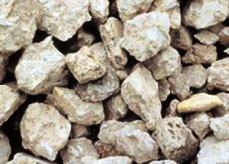Pervious Concrete
Mix Design and Properties
pervious concrete | why use it? | properties | installation | testing | success stories | faqs
MAIN INGREDIENTS OF PERVIOUS CONCRETE
(1) Portland/Blended Cements
Supplementary cementitious materials (SCMs) such as fly ash, pozzolans, and slag can be added to the cement. These influence concrete performance—setting time, rate of strength development, porosity, permeability, etc.
The key to high-performance concrete is the use of SCMs. Silica fume, fly ash, and blast furnace slag all increase durability by decreasing permeability and cracking.
Silica fume is a byproduct of silicone production. It consists of superfine spherical particles which significantly increase the strength and durability of concrete, and is used frequently to produce concrete for high-rise buildings that exceeds 20,000 psi compressive strength. Silica fume can replace cement in quantities of 5-12%.
Fly ash is the waste byproduct of burning coal in electrical power plants. It used to be landfilled, but today a significant amount is used in cement. Fly ash can replace 5-65% of the Portland cement.
Blast furnace slag is the waste byproduct of steel manufacturing. It imparts added strength and durability to concrete, and replaces anywhere from 20-70% of the cement in the mix.
(2) Course Aggregates
Aggregates are kept to a narrow gradation in order to minimize surface roughness, as well as for aesthetic reasons (size 89 has been used extensively).
Aggregates can be either rounded or angular (i.e., pebbles or crushed stone). Typically, higher strengths are achieved with the rounded kind.
Fine aggregates such as sand are used in minimal amounts because they fill the air voids (which creates conventional concrete).
As in the laying of dense concrete, the aggregates must be close to a saturated, surface-dry condition—therefore, water control is important in concrete mixtures.
(3) Water
Too little in a mixture leads to aggregates that are dry and do not place or compact well.
Too much water makes the concrete mixture soupy (paste flows off the aggregates) and eliminates air voids (fills in the spaces between the aggregates).
As a general rule, water that is drinkable is suitable for use in concrete.
(4) Admixtures
Admixtures are chemicals which are added to the mixture to provide the concrete with special properties.
Retarders/hydration-stabilizing admixtures are those that lengthen cement's rapid setting time.
Air-entraining admixtures are those that reduce freeze-thaw damage, and are therefore used in climates where this is a concern.
There are also proprietary admixture products which facilitate the placement and protection of pervious pavements.


